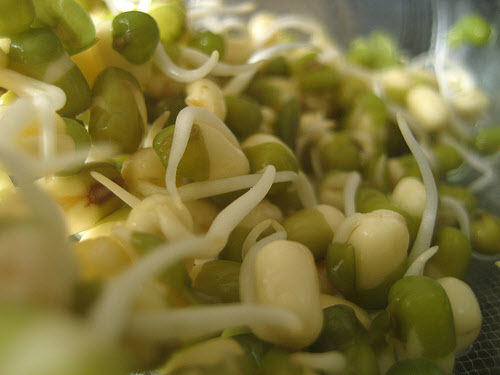
1. Bean sprouts
It is no surprise that the source of the recent, disasterous German E. coli outbreak was bean sprouts. The growing conditions for making bean sprouts (and other sprouts) are perfect for growing human pathogens like E. coli or Salmonella, and the presence of manure and/or compost on Organic farms simply increases the chance of contamination. Remember that it was a farm in transition to Organic that caused the spinach-based outbreak in the US a few years ago. I would only eat sprouts if they were well irradiated.
2. Nutmeg from India
Because of moist conditions and poor storage, nutmeg produced in India is often contaminated with the fungus, Aspergillus flavus. This fungus produces one the the most toxic substances known to man – Aflatoxin. It is this toxin that I am trying to avoid for several items on this list.
3. Organic corn chips
Corn damaged by insects is often infected by the fungus Fusarium moniliforme which makes the mycotoxin, Fumonisin. Consumption of Fumonisin by pregnant women has been linked to higher rates of neural tube defects in their children. Conventional corn is now much less likely to be contaminated because it is protected by the GMO, Bt trait. Organic growers cannot use this trait, so their corn is much more likely to be contaminated.
4. Foods sweetened with “fruit juice concentrate” from China
Many people trying to avoid High Fructose Corn Syrup and processed sugar believe that products with “fruit sweeteners” are better. These now mostly come from China with no adequate system to check for old, nasty organophosphate insecticides that are widely used on crops like apples and pears in China. This is a source of pesticide residues that even I am concerned about.
5. Foods containing transfats
When the press and food manufacturing industry over-reacted to a linkage between “saturated fats” and heart disease, there was widespread use of “partially hydrogenated soybean oil” which turns out to be far, far worse for our hearts because it is a form of fat that never occurs in nature. I have been avoiding this fat for at least 25 years before it was widely recognized as dangerous.
6. Peanuts from Africa or Asia
Fortunately there are few exports of peanuts from Africa or Asia. These crops are frequently contaminated with Aflatoxin. Liver cancer is a leading cause of death in those regions because of this mycotoxin. Fortunately, the Gates Foundation is funding the development of a fast and cheap test so that people can detect the contamination and avoid it.
7. Organic, ready to heat meals
Conventional herbs and spices can be irradiated so that they don’t carry pathogenic bacteria into the recipes where they are used (these are dried outside with no protection from bacterial or fungal contamination). For well cooked foods this is not an issue, but in the fast-growing, “ready-to-cook” segment, these ingredients are mixed in long before heating by the consumer, giving the bacteria time to grow. That is an excellent recipe for food poisoning.
8. Raw milk
Drinking raw milk is like playing Russian Roulette. Sooner or later the drinker will get severely ill. It is particularly dangerous for children. Louis Pasteur figured this out in the 1880s and there is no good reason to stop “pasteurizing” milk.
9. Agave nectar
A major Foodie fad is to eat foods sweetened with “Blue Agave Nectar.” It makes a nice story because it has a lower glycemic index and that makes it easier for a diabetic to control their blood sugar. It turns out that you get more than the sweetener, you get carcinogenic compounds which, as a leading toxicologist puts it, “light up the rat bladder cancer screen.” I think I’ll stick with sugar.
10. Artisan breads with whole wheat “berries”
Wheat can be infected with Fusarium head blight and that fungus often makes the mycotoxin called vomitoxin or DON. The US and Canadian grain elevators do a good job of diverting most of the bad grain to alternative uses or to an incinerator, but grinding the wheat to make flower also does a good job of diluting what gets through that filter and getting DON down to levels that don’t effect anyone. The practice of using whole “berries” in artisan breads means that you can get enough vomitoxin in one piece of bread to make you sick.
11. Brazil nuts
Brazil nuts are a wild crop which grows in the rain forest. The local indigenous people collect nuts that have fallen to the ground. The problem is that you don’t know how long the nut was laying in the mud before it was collected. One Brazil nut can easily contain enough aflatoxin to kill you.
12. Raw peanuts in the shell
Peanuts can also be infected with Aspergillus flavus and contain aflatoxin. In the US peanut industry, the peanuts are shelled and then the exposed nuts are sent down a line through a beam of infrared light. If they fluoresce, a puff of air removes them from the line and they are discarded. The same is done with Almonds and pistachios. With peanuts “in the shell” there is no such screening step. It is not worth the risk to eat them.
You probably noticed how many of these dangerous crops involved aflatoxin. For people in the US and Europe, there isn’t much risk, but fortunately, there is a way you can reduce the risk even further. When eating something that might have traces of aflatoxin (e.g. nuts, peanut butter), be sure to include a green vegetable with the meal. The chlorophyll that makes it green binds with aflatoxin so that you don’t absorb it in your digestive system and it is just peed out. So, one of the best ways to reduce a REAL risk is to eat the very vegetables that the EWG wants to scare you away from eating.
Bean sprouts image from little blue hen at Flickr under a Creative Commons license. My website is Applied Mythology. My email is [email protected].


Bobby
Thanks for the sound reasoning. I was especially impressed that you spoke favorably of irradiating foods, which I think should play a larger role in keeping the food supply safe.
Steve Savage
Bobby,
Thanks. I bet there are a lot of Germans who wish their Organic sprouts had been irradiated! I wouldn’t eat a sprout any other way
Jeff McIntire-Strasburg
Just to clarify, Steve… you mean that for any kind of sprouts, right? I understood your statement in the post (and had read separately) that organic or not, sprouts carry a higher pathogen risk because of the growing conditions.
Steve Savage
Jeff,
absolutely. To make sprouts you take seed (which may easily be contaminated with bacteria) and then incubate them in warm wet conditions which are like Nirvana for the bacteria. Sprouts should either be well cooked or irradiated or avoided
Steve
tom mcmurray
how hard is it to avoid this DD list… piece of cake for all of us…
go forth and eat healthy mainstream foods…
Steve Savage
Tom mcmurray,
Well, I think of apples as a “healthy mainstream food” and it is, in spite of what EWG says. The other thing that EWG fails to mention is that not every crop is tested every year. Last year’s winner, celery, is not suddenly “OK” because the USDA didn’t test it in 2009. They also didn’t test arugala, Brussel sprouts, artichokes or about a hundred other crops. I’m sure they are all safe too, but some year the USDA will demonstrate that and EWG will turn that against them
Steve Savage
Tom, I re-read your post and I think you are saying the same thing I’m saying. Enjoy!